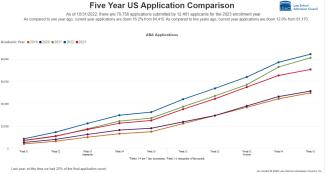Early Trends in the 2023 Admission Cycle
As we released scores from the October LSAT today, it’s a good time to look at the early trends for the 2023 admission cycle.
At this point in the cycle, we typically have about 23% of the total number of applicants and about 20% of the total number of applications. As the last two years have shown, early trends can change over time. The 2021 cycle started relatively slowly, but heated up dramatically over time; last year’s cycle started very strong due to early applicants who had opted out of the 2021 cycle, but then cooled over time. So at this early stage of the 2023 cycle, we’re not making any end-of-cycle predictions.
With that caveat in mind, here are some current trends for the 2023 cycle.
We continue to see applicant volumes lower than 2021 and 2022, but significantly higher than 2019 and 2020. Right now, the number of 2023 applicants is about 14 percent below the number of 2022 applicants at this time last year. We may see that number shift a little in the next week or two, with the release of October LSAT scores, as each score release results in a short-term surge in applicants and applications. Last year, October scores were released about a week earlier, so today’s score release may result in at least some catching-up with last year.

We are seeing similar trends in application volumes. So far, 2023 is lower than 2021 and 2022, and significantly higher than 2019 and 2020. As of October 31, there are 70,758 applications reported, down 16.2% from last year and down 12.8% from 2021. When compared to this point in 2019 and 2020, however, current application numbers are up by nearly 40%. And again, we should see a short-term surge in applications now that October scores have been released.

The proportion of applicants of color continues to be slightly below, but roughly in line with the past five years; currently, about 36% of this year’s applicants identify as a person of color. The proportions of female applicants and gender-diverse applicants continue to be larger than any of the past five years; currently, about 54% of this year’s applicants identify as women, and over 1% identify as gender diverse. We will continue to monitor the diversity trends closely in the weeks and months ahead.
There are several other important data points that are worth noting at this relatively early stage of the cycle. As of October 31, we had about 2,700 fewer first-time test takers registered for the fall LSATs as we had at this time last year. Similarly, there have been about 1,500 fewer CAS accounts created between July 1 and October 31 as we had during the same period last year.
For the October LSAT administration, we had more than 19,000 test takers, including 8,248 first-time test takers. The 43.1% first-time test taker percentage for this year’s October LSAT is lower than the percentage for October 2021, so that indicates some softness in terms of first-time test takers.
As for the November LSAT, we are currently 9 days out from the start of the test and are looking at just over 27,000 registrants. We will of course see some drop-off by next week, but we anticipate at least 20,000 test takers.
LSAC continues our digital engagement campaigns to help build interest in legal education and bolster the pool of prospective law school applicants. These efforts are employed across multiple platforms including email and social media, with targeted messaging designed to help individuals consider a career in law, learn about the path to law school, sign up for the LSAT, and take advantage of a variety of supportive tools and resources. We also have digital campaigns and other outreach efforts specifically designed to attract prospective students from communities that are underrepresented in the legal profession.
Beyond our digital outreach efforts to expand and diversify the pipeline of prospective students, we are seeing solid engagement with our LSAC Law School Forums. We have had more than 6,000 attendees at our forums so far this year, and we look forward to serving more individuals and schools with additional in-person events planned for Houston and Boston, as well as digital forums in November and February.
We will continue to do everything we can to help build the pool of candidates. As always, we refresh the current volume data on our website at https://report.lsac.org/VolumeSummary.aspx on a daily basis.
We will continue to provide periodic updates as the 2023 admission cycle progresses.

